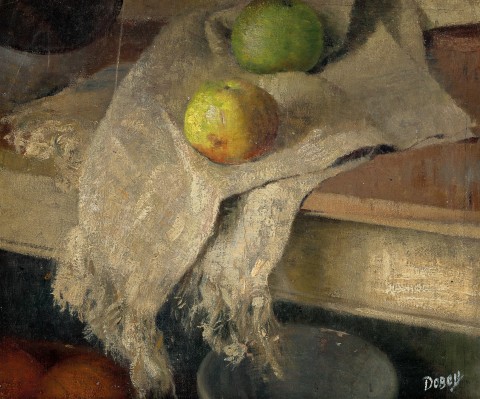APPLES ON A CLOTH, 1932
WILLIAM DOBELL
oil on canvas on composition board
29.0 x 36.0 cm
signed lower right: DOBELL
Camille Gheysens, Sydney
Lawsons, Sydney, 16 September 1979, lot 247 (as ‘Still Life – Apples’)
Private collection, Sydney
William Dobell Retrospective, Art Gallery of New South Wales, Sydney, 15 July – 30 August 1964, cat. 21 (label attached verso)
William Dobell Exhibition, Bendigo Art Gallery, Victoria, 13 – 23 November 1964 (label attached verso)
In 1929, the year William Dobell travelled to London, Margaret Preston wrote that modernist artists of the day used still life compositions as sites for solving artistic problems, akin to a laboratory table.1 In this, she updated a principle that had an important precedent in Dutch art of the seventeenth century where their famed vanitas paintings focussed on profusions of flowers, food and objects traditionally weighted by the inclusion of an insect, skull or rotting fruit as an allusion to human mortality. Such works also provided artists the freedom to experiment with composition, form, tone and proportion, as Preston had noted. Less moralistic still lifes subsequently became widely popular through artists such as Jean-Baptiste-Siméon Chardin and Henri Fantin-Latour before Paul Cézanne broke down the academic template with his tables of cloths and apples which seemed to dissolve in a welter of broken brush marks. Whilst never a true modernist himself (though he came to admire Van Gogh and Renoir), Dobell absorbed many of the ideas and approaches of such artists as he developed his own distinctive, personal style of painting in Europe, enabled by his award of a Travelling Scholarship with two-year financial stipend.
In London, Dobell enrolled at the Slade School of Art and quickly impressed his teachers, Henry Tonks and Philip Wilson Steer, by winning the school’s first prize for figure painting with an intensely naturalistic Nude study in the collection of Newcastle Regional Art Gallery. In his spare time, he haunted London’s major galleries, examining the paintings of Rembrandt, Goya, Daumier, El Greco and others, a practice he continued when travelling through Holland and Paris in mid-1930. The following year, which included a month’s stay in the Belgian town of Bruges, he painted a second Nude, an image startlingly different from the earlier work, with the figure now used solely ‘as a surface that reflects light, and as a vehicle for the expression of a rhythmic sense.’2 Dobell continued to explore this strategy over the following year and Apples on a cloth, 1932, is clearly aligned, with its folded cloth and tangled fringe pulsing with light, illuminated seemingly from within as much as without. There are clear echoes of Rembrandt, particularly in the scumbled white paint, whilst the painterly vigour recalls another of Dobell’s favourites, the Belarusian expressionist Chaïm Soutine. Apples on a cloth was likely painted in Bayswater, possibly at the studio leased by the artist Fred Coventry, and the modesty of the subject gives an indication of the straightened financial circumstances that Dobell now faced following the cessation of his stipend. In a radio interview many years later, he stated that he felt compelled to continue in earnest, that ‘I’d been sent over on scholarship and I should not come back until I could show I’d gained something from it, benefited by the trip.’3 With captivating results such as the present Apples on a cloth, as well as Self-portrait, and the jewel-like Boy at a basin, all from the same year (the latter two now in the collection of the Art Gallery of New South Wales), Dobell’s enlightened decision and continued dedication underpinned his subsequent career as one of this country’s leading artists of the twentieth century.
1. See Margaret Preston, ‘aphorism no 46’, 1929 in Sydney Ure Smith and Leon Gellert (eds.), Margaret Preston recent paintings 1929, Ure Smith, Sydney, 1929.
2. Gleeson, J., William Dobell, Thames and Hudson, London, 1964, p. 25
3. William Dobell, interview with Garth Nettheim, 9 July 1963, cited in Bevan, S, Bill: the life of William Dobell, Simon and Schuster, Sydney, 2014, p. 67
ANDREW GAYNOR
